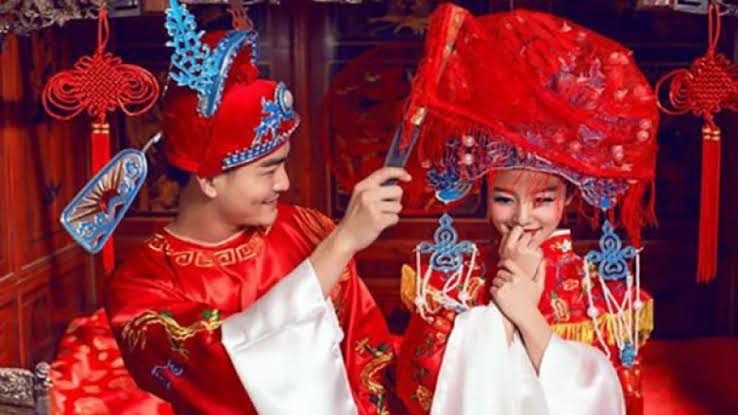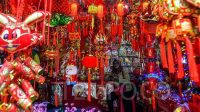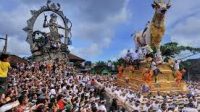KUPASONLINE.COM — Chinese wedding customs, like other wedding customs, have historical wisdom that is rich in meaning. Broadly speaking, the processions that accompany the wedding moments of every couple of Chinese descent are divided into 3 stages, namely before the wedding, wedding, and after the wedding. The following details the preparations that must be made by the bride and groom for each process:
Procession Before the Wedding Day
Application:
For the application process, there are couples who rely on their elders to determine the time, and there are also those who don’t pay much attention to this matter of time. The most important role in this process is held by a person who acts like a ‘matchmaker’ sent by the male party. This ‘Matchmaker’ will send a message to the woman’s family that their sons and daughters are the right match to go down the aisle.
Determination:
If the signal from the matchmaker receives a positive response, then both parties can determine when the next process, namely Sangjit, may be carried out.
Sangjit:
This process is important in the wedding ceremony of every Chinese couple. The right time to do sangjit can be consulted with parents who understand calendar issues. Sangjit is usually held between 1 month and 1 week before the wedding reception and takes place during the day between 10.00 and 13.00 WIB followed by lunch.
Preparation of the groom’s family:
Items handed over by the sangjit in the form of 12 trays which will later be handed over to the prospective bride’s family, including: Cosmetics and toiletries; a set of jewelery for the bride; Clothing/fabric and accessories for the bride; Milk money (ang pao) and party money (each in a red envelope). This money can be taken in part or in whole with the respective consequences; Three trays of 18 pieces each; Two pairs of sizable red candles tied with red ribbons; A pair of pork legs (canned food can be substituted if not available) and 6 cans of peas; One tray contains 18 pieces of red cupcakes; One tray holds two bottles of wine or champagne; As well as a tray containing a combination of gold coins, two bundles of double happiness ribbons, glass and one cake.
Preparation of the bride’s family:
Return delivery in the form of; Presents from the groom’s party which were only taken in part, such as milk money and party money, a fruit tray, 1 pair of red candles, some pig’s feet/substitutes and cans of peas, some cupcakes, two bottles of red syrup; A tray of sweet foods such as candy or chocolate; As well as a tray of men’s needs, such as a pair of clothes, underwear and handkerchiefs.
The family also has to prepare several envelopes of ang pao money which are ready to be distributed to the tray bearers from the groom’s side with an adjusted nominal amount.
Fiancé:
This process is an introduction to each family member of the two parties so that closer kinship is established between the male and female families. After the introductions, it was continued with a meal together.
Good Timing:
Chinese custom really upholds the importance of the correct calendar for every sacred moment. Must choose a good hour, day and month. Usually everything is very young, namely: the hour before the sun is perpendicular; days depending on the calculation of the Chinese month, and a good month is the rising / full moon. This matter should also be discussed with the families of both parties. In addition to determining the exact calendar for the wedding day, it is also determined an auspicious day for the ceremony.
Sheet Installation:
This process is carried out by the groom’s family at the residence of the bride’s family. The organizers of this event are the groom’s family who are married and live happily as a venue to show examples of harmonious household life from the groom’s family members. In addition to installing sheets, various decorative items for the room are placed and a dowry set is placed on the bed. The time to carry out this procession is determined according to the proper calendar.
Liauw Tiaa Ceremony (Bachelor’s Party):
Held the night before the wedding ceremony is held the next day. The ceremony was attended by friends of the bride and groom and held at the bride’s house.
Wedding Process on D-Day
Cia Tao Ceremony:
This process is carried out in several stages, which essentially pay homage to God, nature, ancestors, parents and the bride and groom. This prayer ceremony begins with praying at home and then continues with a prayer ceremony at the temple and then returns home to pay respects to parents or people who are
old.
Ceremonial:
A series of processions held at this monastery are led by a priest and nuns. They will later give blessings to the two bride and groom.
Tea Pie:
This ceremony is an event that will be attended by parents from both parties as well as people who are elders. In this event each family member gives advice to the prospective bride and groom so that the household they are fostering can run in a lasting and harmonious way. In addition to giving advice, each of them gave a gift which could be in the form of jewelry, money, and household items which would be useful to help the economy of this young family in the future.
Wedding reception:
After the religious event, a wedding reception is held at home or at the reception venue. The bride and groom usually wear wedding gowns and suits.
Post-Wedding Process
Cia Kiangsay:
In the ceremony of entertaining the groom (“Cia Kiangsay”) the point is to introduce the groom’s extended family at the bride’s house. The groom is allowed to live together.
Cia Ce’em:
The Cia Ce’em ceremony is held at the groom’s house. The purpose of holding this event is to introduce all members of the bride’s extended family. After this event, the newlyweds visited the homes of relatives where their parents were still present.(*)







